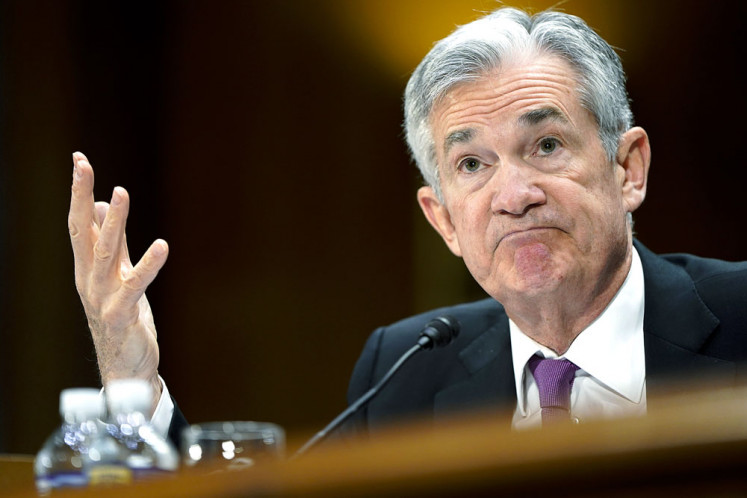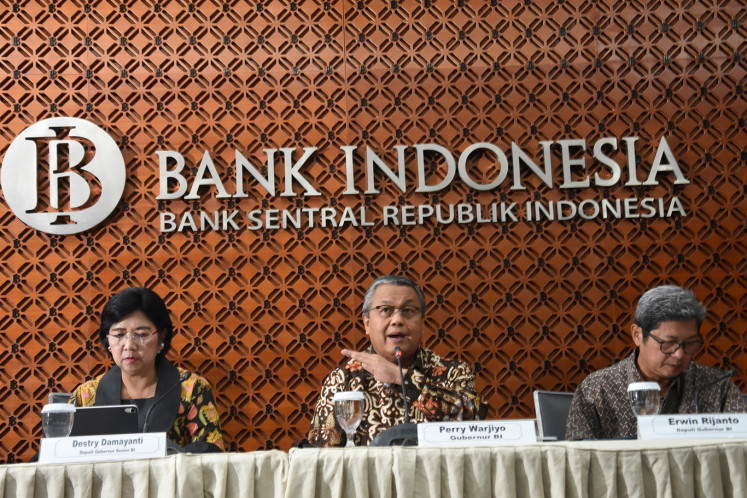Popular Reads
Top Results
Can't find what you're looking for?
View all search resultsPopular Reads
Top Results
Can't find what you're looking for?
View all search resultsWhat central banks did last week as COVID-19 spread hit global markets
Global central banks stepped up their crisis-fighting last week in a campaign to keep markets functioning and economies growing amid COVID-19 spread.
Change text size
Gift Premium Articles
to Anyone
 A woman wearing a mask gesture 'two' to confirm the limit set by this supermarket in London for toilet paper packs on March 14, 2020, as consumers worry about product shortages, leading to the stockpiling of household products due to the outbreak of the novel coronavirus COVID-19. (AFP/Justin Tallis)
A woman wearing a mask gesture 'two' to confirm the limit set by this supermarket in London for toilet paper packs on March 14, 2020, as consumers worry about product shortages, leading to the stockpiling of household products due to the outbreak of the novel coronavirus COVID-19. (AFP/Justin Tallis)
G
lobal central banks stepped up their crisis-fighting last week in a campaign to keep markets functioning and economies growing as the coronavirus looks increasingly likely to tip the world into its first recession since the financial crisis. Among the tools deployed: interest-rate cuts, asset purchases, currency interventions and liquidity injections.
Markets reacted just as aggressively. Trading volatility spiked to levels not seen since the financial crisis as the S&P 500 Index’s historic bull run came to an end and signs of illiquidity emerged across debt markets.
Even the US$17 trillion US government-bond market wasn’t immune, with the gap between prices bid and sellers’ offers widening sharply. Meanwhile, the dollar staged its biggest jump in 12 years, climbing to a three-year high, as investors piled into haven assets.
With more action likely this week, here’s a rundown of what happened last week.
Read also: Fed slashes rates, rips open crisis tool kit to cushion coronavirus blow
The US Federal Reserve
Just over a week since cutting interest rates in an emergency move, the Fed offered markets trillions of dollars in liquidity to counter signs of dysfunction. It said it would provide temporary loans to banks in coming weeks to relieve strains as investors sold government bonds to raise cash.
The Fed will also purchase a broader range of government securities than just short-term Treasury bills to make sure the liquidity reaches elements of the market which need it most.
On Sunday, the central bank swept into action to save the US economy from the fallout of the coronavirus by slashing its benchmark interest rate by a full percentage point to near zero and promising to boost its bond holdings by at least $700 billion.
Federal Reserve chairman Jerome Powell delivers the Fed’s semiannual monetary policy report to the Senate banking committee in Washington, DC, on Tuesday. Powell addressed issues that could effect the economy, including trade with China, Brexit, inflation and public debt. (AFP/Joshua Roberts)The Fed also announced several other actions, including letting banks borrow from the discount window for as long as 90 days and reducing reserve requirement ratios to zero percent. In addition, it united with five other central banks to ensure dollars are available around the world via swap lines.
Fed Chairman Jerome Powell said that he did not think negative rates, which have been used in Europe and Japan, would be appropriate policy in the US.
The Bank of Japan
It offered the market up to 2.2 trillion yen ($20.7 billion) in cash injections in three different operations on Friday, while snapping up stock funds for the sixth time this month. It also pledged to maintain liquidity and keep markets stable this month.
The yen weakened versus all of its major peers on Friday as domestic stocks tumbled. Japan’s currency is still up this year against all of its G-10 counterparts except the Swiss franc.
Officials convene next Wednesday and Thursday with people familiar with the matter saying they are likely to show a more aggressive stance on buying assets such as exchange-traded funds. Whether the BOJ will raise its 6 trillion yen ($58 billion) ETF-purchasing target remains unclear and could depend on the severity of market conditions at the time of the meeting, the people added.
European Central Bank
The ECB tried a nuanced approach. It promised to buy more bonds, and enhanced a loan program with terms that effectively amount to an interest-rate cut for banks that use it to pump money into the economy.
But it didn’t cut its deposit rate further below zero, which disappointed investors, and President Christine Lagarde drew criticism for comments which sent Italian bonds into a tailspin and had to be clarified.
Read also: Europe grinds to halt as ECB is criticized for too little action
European stocks also buckled and the euro weakened before stimulus announced by Germany boosted risk appetite Friday. Yields on the German 30-year bond surged the most in a decade on the prospect of fiscal action.
Bank of England
The Bank of England started Wednesday early by unveiling stimulus including its first emergency rate cut since the financial crisis. It delivered a half-point reduction to take the key rate to 0.25 percent, introduced a new program to provide easy and cheap credit, and reduced a special capital buffer to give banks even more room to lend.
It acted on the same day the UK government announced its budget, giving a sense of coordination that investors wanted. Incoming Governor Andrew Bailey made clear it has space if it needs to do more.
The pound swung between gains and losses on the day, and ended the week down 5.9 percent against the dollar, the most on a closing basis since 2009.
People’s Bank of China
The world’s number-two economy cut the amount of cash that banks have to set aside as reserves. It offered discounts to commercial lenders’ reserve ratios of a half or 1 percentage point from their original level.
Joint-stock banks will get an additional reduction of 1 percentage point, and together the cuts will release 550 billion yuan ($79 billion) of liquidity, the PBOC said.
Bank of Canada
It surprised on Friday by cutting rates by half a percentage point as its economy is hit by the virus and falling oil prices. It said it “stands ready” to act again and also announced a new facility to acquire money market instruments used by small- and medium-size businesses.
That was the second rate cut in two weeks, and on Thursday it had announced it planned to volley billions of dollars into markets. Eyes are now turning to Prime Minister Justin Trudeau’s government for a fiscal effort.
Read also: Indonesia deploys second stimulus amid market, rupiah routs
Reserve Bank of Australia
Having also cut interest rates this month, on Friday it injected A$8.8 billion ($5.5 billion) in its open-market operations, the most in at least seven years.
Reserve Bank of India
Keen to keep the rupee stable, it plans to add 250 billion rupees ($3.4 billion) through short-term repurchase operations after announcing Thursday a $2 billion injection into the foreign-exchange market.
Brazil
Its central bank used a wide array of market interventions this week to support one of the worst performing currencies in the world. In one week, policy makers intervened using auctions of lines, swap, roll-overs and dollars in spot markets, accumulating sales of around $17 billion through separate auctions.
This week will also come to effect a measure announced on Feb. 20 that freed up to 135 billion reais ($28.2 billion) in reserve requirements and other prudential measures, allowing increased liquidity to banks.
Sweden’s Riksbank
It lent up to 500 billion kroner ($51 billion) to banks to maintain the supply of credit to companies. The measure “should be regarded as a form of insurance that enables Swedish companies –- particularly small and medium-sized enterprises –- to feel secure that the credit supply will not fail,” said Governor Stefan Ingves.
Norges Bank
It also acted outside of its normal calendar on Friday to cut its benchmark to 1 percent from 1.5 percent. It said it’s “monitoring developments closely and is prepared to make further rate cuts.”
Read also: Bank Indonesia spends Rp 110t to stabilize markets as virus stokes sell-off
The Bank of Korea
It said it’s considering a special meeting to tackle wild swings in the foreign-exchange market. The bank also said it would take steps to stem excessive foreign exchange movements.
Bank of Indonesia
Its central bank bought 6 trillion rupiah ($405 million) of government bonds on Friday to prop up financial markets, adding to 8 trillion rupiah of bonds purchased Thursday.
Bank Indonesia Governor Perry Warjiyo (center) accompanied by Senior Deputy Governor Destry Damayanti (left), and Deputy Governor Erwin Rijanto, gave a press statement regarding policy measures to maintain monetary and financial stability due to the impact of the corona virus in the Bank Indonesia Building, Jakarta, Monday (2) / 3/2020). Bank Indonesia prepares five steps to maintain economic stability including increasing the intensity of triple intervention so that the rupiah exchange rate moves according to market fundamentals and mechanisms, decreasing the Statutory Reserves Ratio in Foreign Conventional and Sharia Commercial Banks, and expanding the types of underlying transactions for foreign investors (Antara/Indrianto Eko Suwarso )Paraguay
Its central bank made a surprise quarter point cut, reducing borrowing costs to 3.75 percent from 4 percent at a meeting that took place 10 days before the scheduled date.
Bank of Mexico
Banco de Mexico expanded the maximum amount that could be issued under an existing non-deliverable forward hedge program to $30 billion from $20 billion on Monday after a steep sell-off in the Mexican peso. In an effort to increase liquidity and stabilize peso volatility, Banxico acted again on Thursday, auctioning $2 billion in hedges.
Colombia
Colombia’s central bank said it will auction 30-day non-deliverable forwards, and won’t directly sell reserves. They say this is to provide liquidity at a time of volatility, rather than an attempt to influence the value of the peso.











